Key takeaways:
- Effective IT documentation enhances clarity, operational continuity, and team communication, especially during critical situations.
- Key types of documentation include User Manuals, Technical Documentation, Process Documentation, Troubleshooting Guides, and Maintenance Logs, which streamline operations and improve responsiveness.
- Best practices for documentation involve consistency, regular updates, and a user-centric approach to ensure information is accessible and useful.
- Measuring documentation effectiveness through user feedback and tracking support tickets helps identify gaps and improve clarity, transforming documentation into a valuable resource.
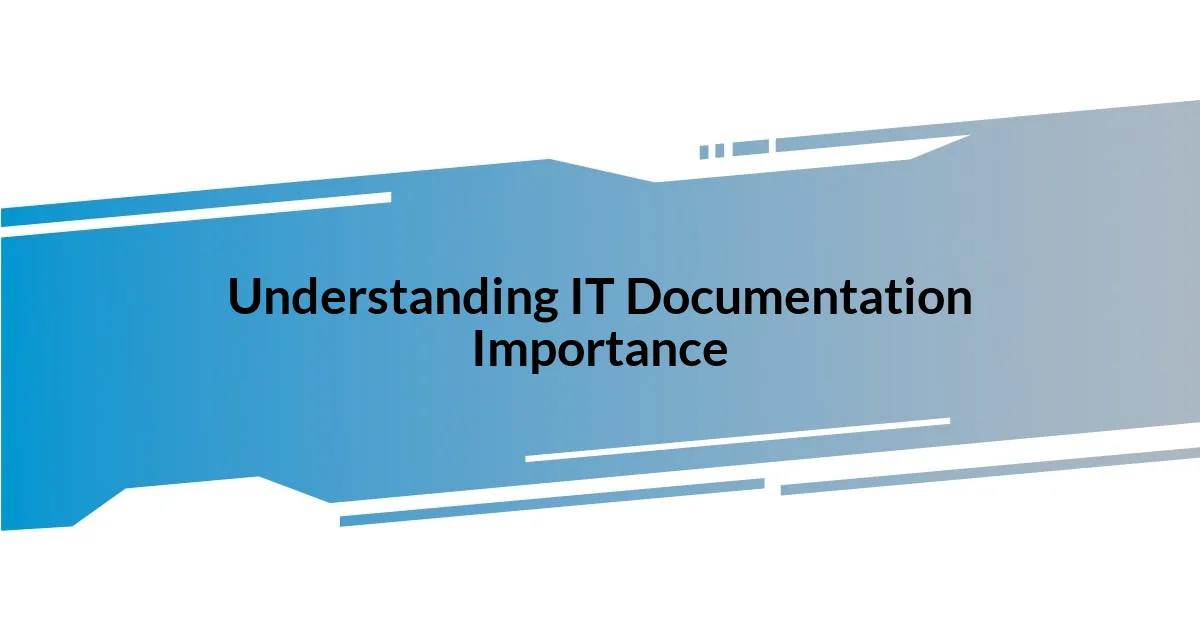
Understanding IT Documentation Importance
Effective IT documentation serves as the backbone of any tech-driven organization. I’ve seen firsthand how a well-organized knowledge base can transform confusion into clarity during high-pressure moments. Have you ever been on the verge of a deadline, only to realize all the information you need is scattered across various platforms? That experience can be incredibly frustrating.
In one of my previous roles, there was a chaotic moment where a critical system failed, and we scrambled to find relevant documentation. The panic in the room was palpable, yet it highlighted a vital lesson: having clear, accessible documentation can be a lifesaver. It enables teams to resolve issues quickly and maintain operational continuity. Isn’t it reassuring to think that all the knowledge one needs can be a click away?
Moreover, good documentation fosters better communication within teams and enhances onboarding for new employees. I remember how overwhelming it felt to join a new company without a solid documentation framework; it felt like stepping into a new world without a map. By investing time in creating comprehensive IT documentation, teams empower their members and improve overall efficiency and collaboration. Wouldn’t it be great to work in an environment where everyone is on the same page?
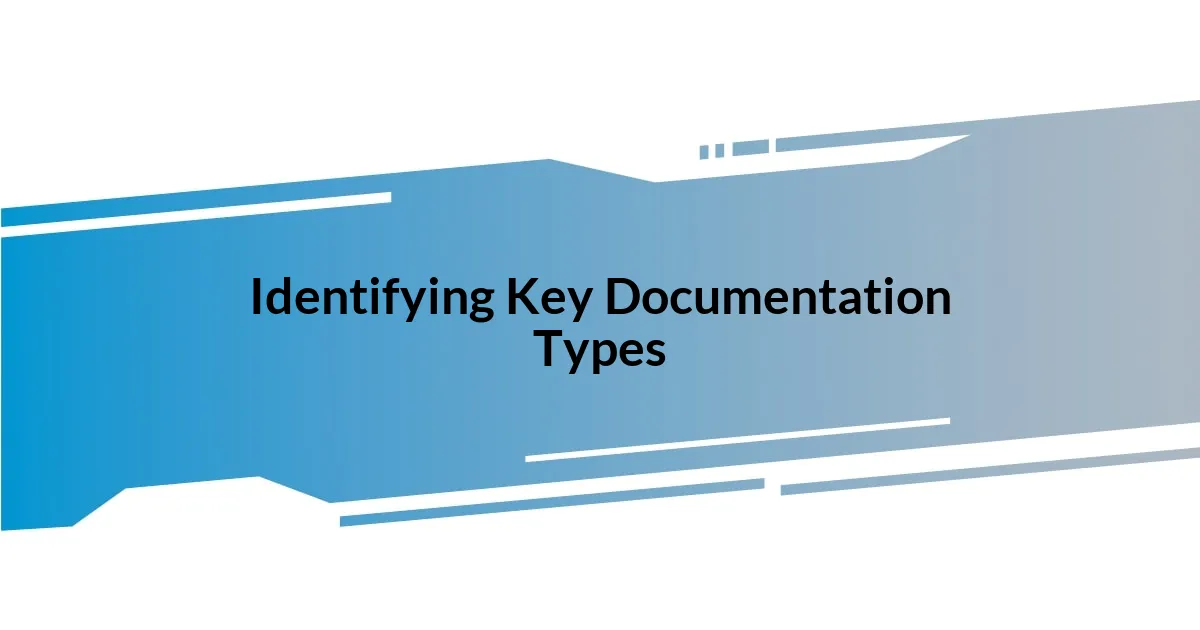
Identifying Key Documentation Types
Identifying the right types of documentation is crucial for effective IT management. From my experience, different documentation serves various purposes, and knowing which to prioritize can save time and frustration later. I recall a project where we created a foolproof plan by categorizing our documentation into specific types. This approach helped us quickly pinpoint what we needed during critical times.
Here are the key types of IT documentation I’ve identified as essential:
- User Manuals: Detailed instructions on how to use software or systems.
- Technical Documentation: In-depth information about system architecture, APIs, and integrations.
- Process Documentation: Step-by-step guides outlining workflows and procedures.
- Troubleshooting Guides: Quick solutions for common issues that users may encounter.
- Maintenance Logs: Records of system maintenance, updates, and changes.
By focusing on these types, I’ve found teams can significantly streamline their operations and enhance their responsiveness when challenges arise. It’s remarkable how much clarity and efficiency well-structured documentation can bring to a team.
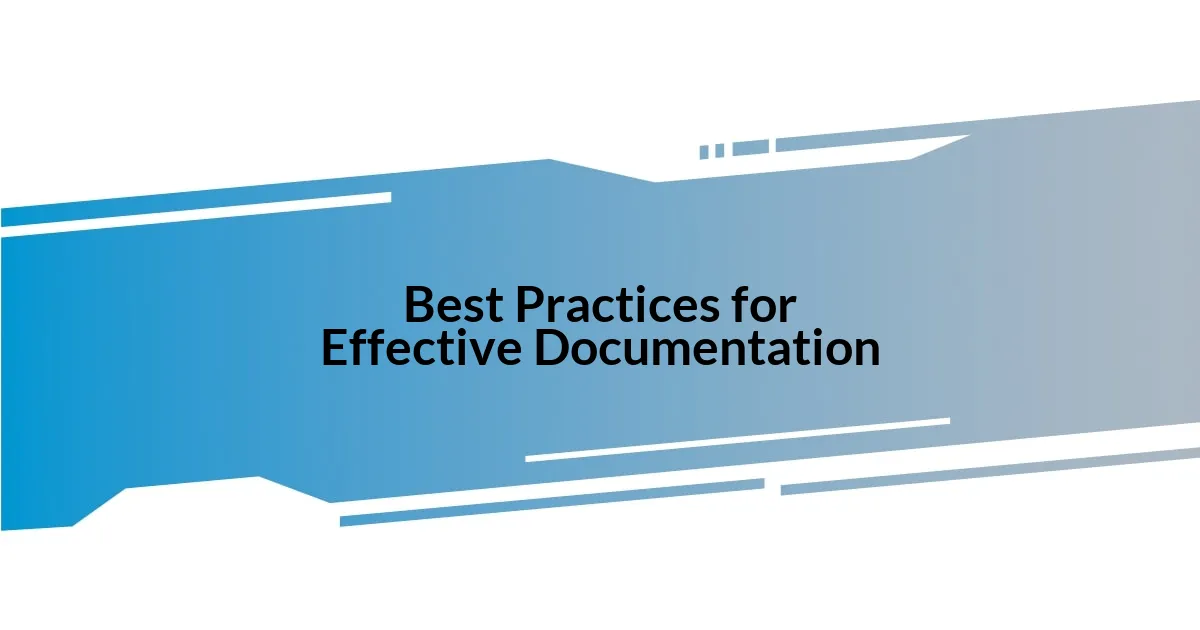
Best Practices for Effective Documentation
Best Practices for Effective Documentation
When I think about effective documentation, one practice stands out: consistency. I learned this the hard way when my team utilized different formats for our documents. Over time, it created unnecessary confusion, and I found myself lost while searching for information. Establishing a consistent style guide can alleviate that chaos, enabling any team to navigate their documents with ease. Wouldn’t it be great to eliminate the headaches caused by format inconsistencies?
Another vital practice I discovered is the importance of keeping documentation up-to-date. I can’t stress this enough. I remember encountering outdated documents during a critical incident, which led to time wasted and increased stress among my team. Regularly reviewing and updating documentation ensures that everyone is working with the most current information. Imagine how efficient our processes would be if we eliminated that guesswork!
Lastly, user-centric documentation is essential for truly effective IT documentation. In one of my projects, we included end-users in our documentation review process. What a game changer! We gathered insights on what they found useful and what puzzled them. Their feedback was invaluable in refining our documents. Creating documentation with the end-users’ needs in mind makes it not just informative but genuinely helpful.
| Best Practices | Benefits |
|---|---|
| Consistency | Eliminates confusion and increases ease of navigation. |
| Regular Updates | Ensures accuracy and relevance of information. |
| User-Centric Approach | Makes documentation genuinely useful and accessible. |
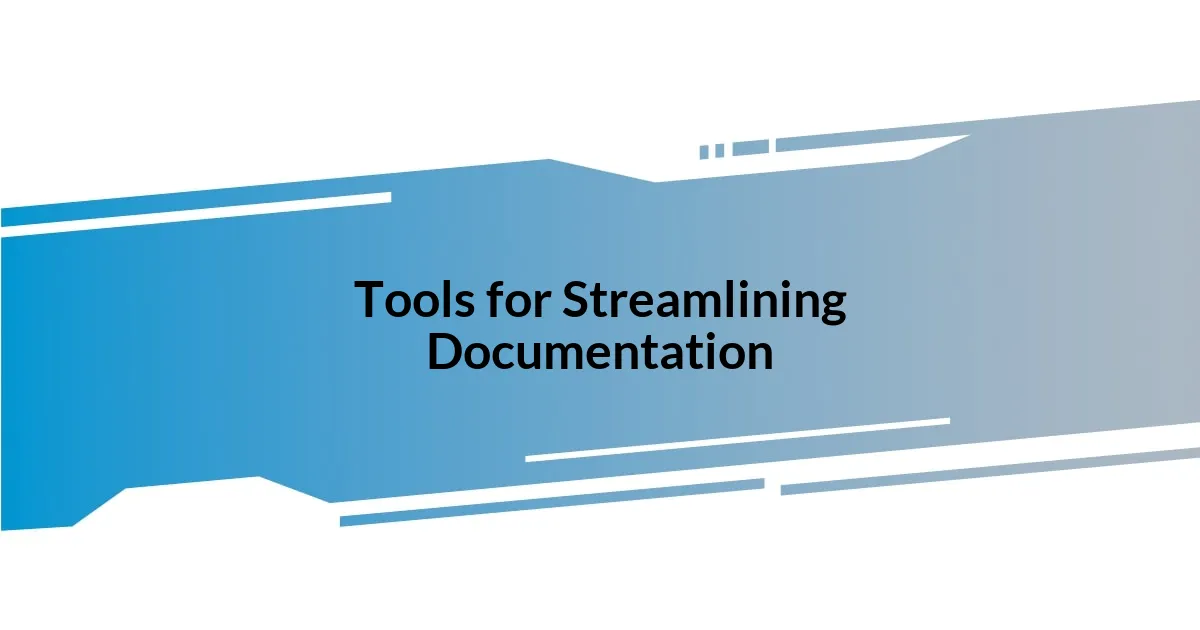
Tools for Streamlining Documentation
When it comes to tools for streamlining documentation, my go-to has been Confluence. I stumbled upon this tool during a particularly chaotic project where we struggled with information overload. It was like finding a compass in the fog! Confluence allows teams to create, share, and organize their documentation in a user-friendly way, making it easy to retrieve what we need quickly. Do you ever feel overwhelmed by scattered files?
Another impressive tool I’ve discovered is Notion. I was initially skeptical about its flexibility, but I’ve found that it excels in allowing teams to customize their documentation spaces. In one project, I used Notion to build a centralized hub where all our guides and technical docs could coexist. It was eye-opening to see how a cohesive layout improved team collaboration, enabling everyone to contribute effortlessly. Have you ever watched your team thrive just by having the right tools in place?
Lastly, I can’t overlook the impact of version control tools like Git. I remember a time when my colleagues and I scrambled to track changes across multiple versions of our documents. Git transformed that experience by providing a systematic way to manage revisions. Now, I feel relieved knowing that we can always reference previous edits, which is especially important when working on collaborative projects. Don’t you think having that level of organization can drastically reduce stress?
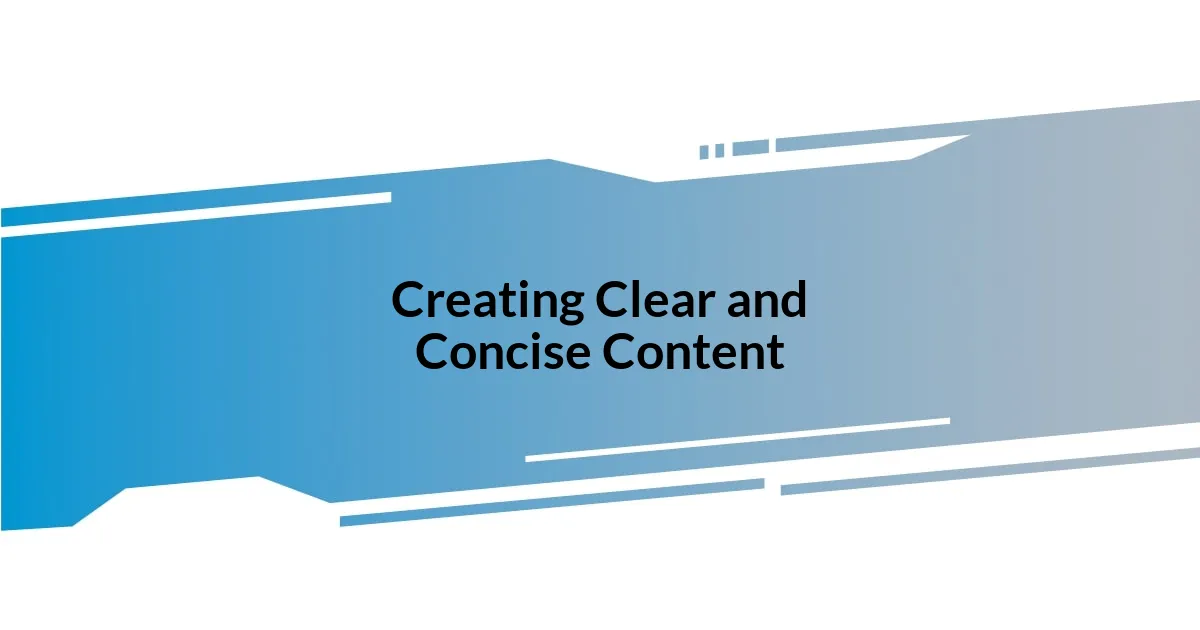
Creating Clear and Concise Content
Creating clear and concise content in IT documentation is essential to ensuring that users can easily grasp the information. I once found myself sifting through a long, jargon-heavy manual that seemed to dance around the point. It was frustrating and made me ponder: why complicate things? Simplifying language and breaking down complex ideas into digestible chunks not only enhances clarity but also invites users to engage with the content more readily.
In my experience, the structure of content plays a pivotal role in clarity. A particularly memorable project involved creating step-by-step guides. Initially, my team tried to cram everything into long paragraphs, but the result was akin to trying to navigate a maze blindfolded! Once we switched to bullet points and headings alongside brief explanations, I noticed a dramatic improvement. The information became accessible, and my team not only found it easier to understand, but they also appreciated the brevity—after all, who has time to wade through unnecessary words?
Moreover, it’s important to keep the audience in mind while drafting documentation. I remember receiving feedback from a junior developer who said that some terms felt out of reach. It echoed an essential truth: our language needs to resonate with our readers. Asking for feedback is an invaluable practice. By prioritizing the reader’s perspective, we enhance the effectiveness of our documentation, making it feel less like a chore and more like a valuable resource. Isn’t it rewarding to see users genuinely benefit from your hard work?
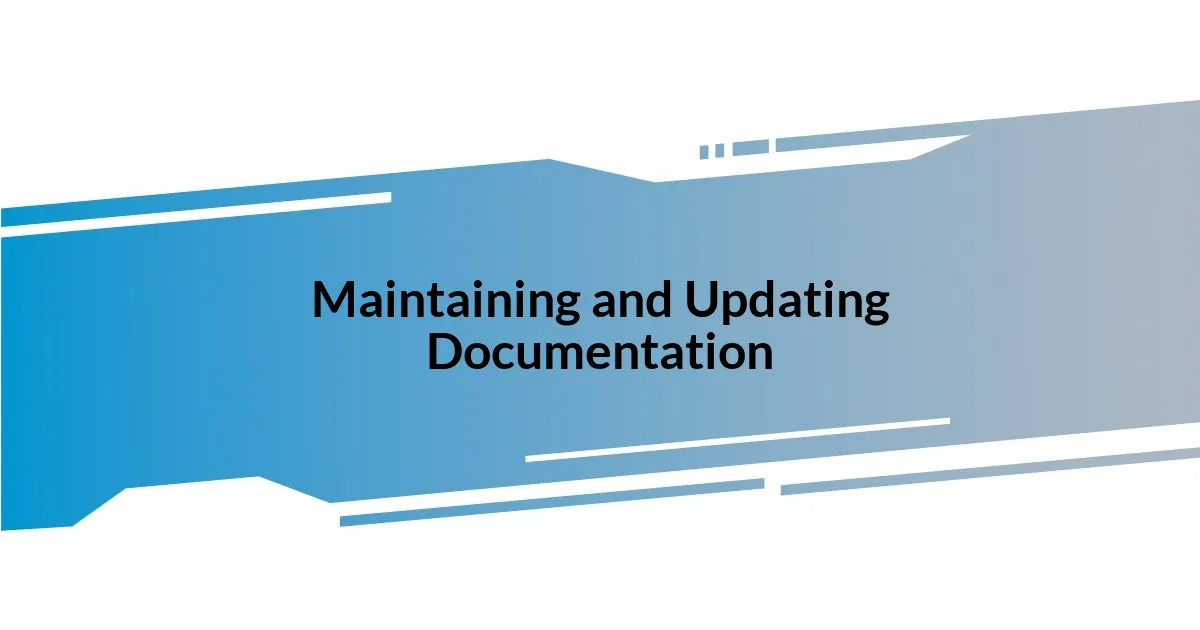
Maintaining and Updating Documentation
Maintaining and updating documentation is not just a box to tick; it’s an ongoing commitment that reflects the evolving nature of IT projects. I recall a time when we let our documentation fall behind during a product update. It felt chaotic and disorganized, something akin to trying to find a specific piece of clothing in a messy closet. When I finally prioritized regular updates, I discovered that having a routine in place transformed our approach. Scheduling reviews at regular intervals allowed us to refine the content and ensure everything remained relevant and accurate.
One key insight I’ve gained is the importance of collaboration during the updating process. I remember an instance where I invited my whole team to brainstorm during a documentation review session. What started as a simple update turned into a lively discussion that unearthed new ideas and improvements. Engaging others in this way not only lightened the workload but also brought fresh perspectives that enriched our documentation. Have you ever experienced that spark of creativity from team collaboration? It’s those moments that truly enhance our collective output.
Additionally, leveraging tools to aid in maintaining documentation can be a game changer. When I discovered automated reminders in Confluence, I thought, “Why didn’t I do this sooner?” It ensured we were consistently reminded to review and update our documents, making it feel less like a chore and more like an integral part of our workflow. This proactive approach cultivated a culture of diligence and accountability within my team. Isn’t it fascinating how small processes can lead to significant improvements in our documentation strategy?
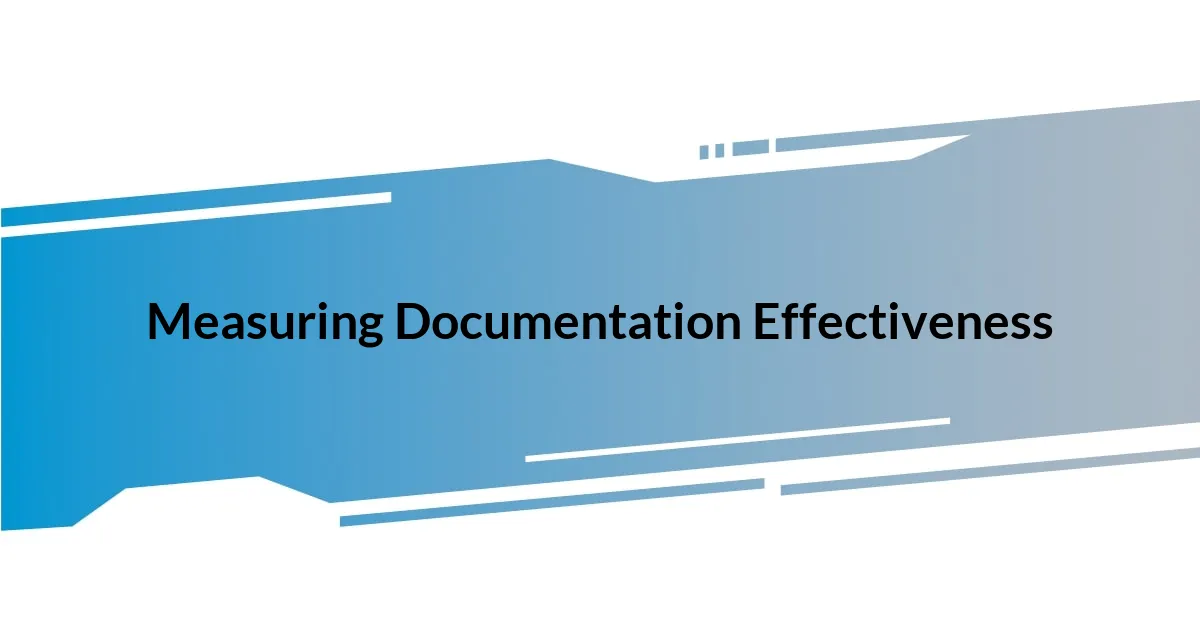
Measuring Documentation Effectiveness
Measuring the effectiveness of documentation can often feel like a daunting task. From my experience, utilizing user feedback is one of the most telling metrics. I once implemented a simple survey after a training session, asking participants how helpful they found the documentation. The insights were eye-opening! Some parts were clear as day, while others elicited responses like “huh?” It became clear that understanding our audience’s perspective was crucial in identifying gaps and addressing them effectively.
Another indicator I’ve found invaluable is tracking the number of support tickets related to documentation. In a previous role, we noticed a spike in tickets referencing a specific feature. That prompted a team meeting, and we dove into the documentation surrounding that feature. It turned out the instructions were too vague, and clarifying them helped reduce the number of incoming queries significantly. Doesn’t it feel empowering to turn feedback into actionable change?
Analyzing how often a document is accessed can also provide insight into its usefulness. During one project, I monitored user interactions with our internal wiki and found that certain documents were hardly opened. It was like discovering a beautiful book gathering dust on a shelf! Armed with that data, I reached out to stakeholders to discuss trimming or reorganizing the underused materials. This proactive approach ignited interest in what we had to offer, transforming static files into dynamic resources for my team. Isn’t it exciting to imagine how data-driven strategies can breathe new life into documentation?